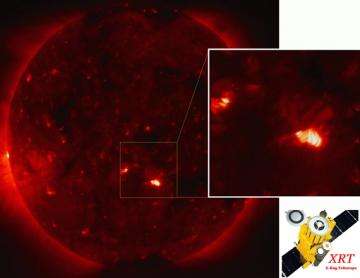The sun's corona glows eerily orange in this image taken on October 28, 2006 by the X-ray Telescope on board the Hinode (formerly Solar-B) spacecraft. The bright region in the inset box shows magnetic fields that have just emerged from the solar interior, producing a new active region. During the current, quiet phase of solar activity (sunspot minimum), the corona is dominated by small regions of closed magnetic field (called X-ray Bright Points) and large dark areas where the magnetic field of the sun extends into interplanetary space (called Coronal Holes).
Just in time for Halloween, astronomers have taken a haunting new portrait of the sun. In this color-coded image from the Hinode spacecraft (formerly Solar-B), the sun glows eerily orange as though celebrating with earthly spooks.
The photograph shows the sun's corona - the top layer of the sun's atmosphere, a region of extremely rarefied gases heated to millions of degrees. During the current, quiet phase of solar activity (sunspot minimum), the corona is dominated by small regions of closed magnetic field (called X-ray Bright Points) and large dark areas where the magnetic field of the sun extends into interplanetary space (called Coronal Holes). There is also a low level of activity as a few small active regions emerge from inside the sun.
The bright region in the inset box shows magnetic fields that have just emerged from the solar interior, producing a new active region.
When the image is seen at full resolution, compact loops of 3-million-degree gas are clearly seen. Movies made from sequences of images will show how the corona evolves, and what conditions lead to the entire range of solar activity from flares and large-scale eruptions to small-scale magnetic reconnection events and explosive jets.
The Hinode spacecraft carries three telescopes. This image was taken with the X-ray Telescope developed jointly by the Smithsonian Astrophysical Observatory (SAO) and the Japan Aerospace Exploration Agency (JAXA). Hinode's X-ray Telescope is the highest resolution solar X-ray telescope ever flown. It will show the structure and dynamics of the corona over a wide range of temperatures and a broad field of view.
Source: Harvard-Smithsonian Center for Astrophysics
























